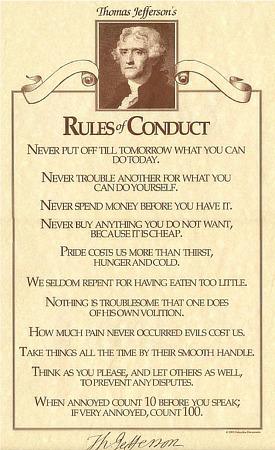 Thomas Jefferson, author of the American Declaration of Independence, wrote these words in a letter to a granddaughter in 1811. This “canon” was one of several in a famous document known as “A Dozen Canons of Conduct in Life.” The canons are rules–advice–for living a good life.
Thomas Jefferson, author of the American Declaration of Independence, wrote these words in a letter to a granddaughter in 1811. This “canon” was one of several in a famous document known as “A Dozen Canons of Conduct in Life.” The canons are rules–advice–for living a good life.
As an autism parent, I have always been drawn to this one. Let’s read it again:
“Nothing is troublesome that one does of his own volition.”
So, if you do something willingly or voluntarily, “of your own volition,” it is not a chore, it is not difficult. It may even be something that you do gladly, perhaps even with joy. Hmm.
What does that have to do with autism? Well, for many children with autism, the opportunity to do something “of their own volition” is very rare. Our children are expected to perform or behave in certain ways, even though they may not have the capacity to do those things. They have language deficits and sensory issues which affect them in myriad ways. They cannot comply with the norm, and as a result are often isolated or punished. Every autism website has heart-breaking stories about the difficulties these children encounter and the resulting agonies for families in trying to get help. It’s a situation ripe for failure, outbursts, emotional reactions, and despair for everyone involved.
So, how can we change this? How can we give these children the functional skills they need to do well in the home and in the community, and how can we do it without punishment or coercion? How can we allow our children with autism more opportunities to do things “of their own volition”?
The answer is: use the principles of Applied Behavior Analysis (ABA), particularly the principle of positive reinforcement. This scientific law states that behavior that is reinforced is behavior that will occur again. So, a desired behavior can be built up in small increments, by reinforcing it whenever it happens.
Well, that sounds complicated. Luckily, we now have TAGteach, Teaching with Acoustical Guidance, which makes the work of positive reinforcement very easy and quick. TAGteach uses an acoustical signal, a click (also referred to as a “tag”), to mark a desired behavior when a child performs it. You watch the child, click (or “tag”) the moment he does something you like, then you give the child a treat (a tiny piece of candy, a token, or other reinforcing object). Then what? You sit back and wait for the child to do something else that you like, then tag and treat that behavior.
How do you know when and what to tag? From observing your child you will know what behaviors you would like to see. Many children with autism have difficult behaviors such as screaming, running around and spinning, which they do endlessly. Behaviors you would like to see could be Quiet Mouth, Both Feet On Ground, Good Eye Contact.
You cannot force your child to perform these behaviors, but by sheer random chance, there will be micro-seconds when your child is doing these things. At some point a child’s mouth will be still (or saying an appropriate word or sound); at some point a child will stop storming about and have Both Feet On The Ground; at some point a child will happen to cast his eyes in your direction. You can capture these micro-seconds with a tag and a treat. Press the tagger the moment you see one of these fleeting behaviors, then hand the child a treat. The behavior you tagged will occur more often. The behavior you tagged will start to last longer. If you keep tagging that behavior every time you see it, the behavior will become stronger.

And guess what, your child will experience no coercion. He will perform the desired behavior because he wants to, of his own volition. And once he learns to do a few behaviors without coercion, the path is clear to learn many more behaviors, freely, happily, and without “troublesome” reactions. TAGteach gives the gift of choice, the gift of freedom, and the gift of learning to a child with autism.
Thomas Jefferson lived from 1743 – 1826. He was the author of the Declaration of Independence, a Founding Father, and Ambassador to France; he served as Vice President and President of the United States. He lived many years ago, yet his words live on and give us meaning in the present day, even in the autism community.
Comments are closed.